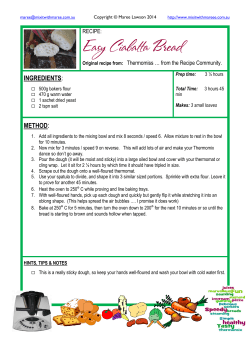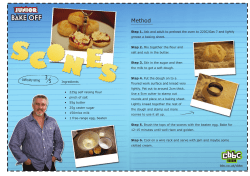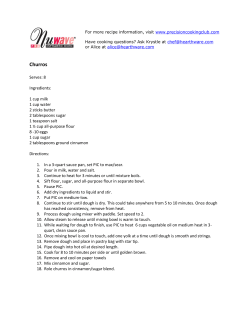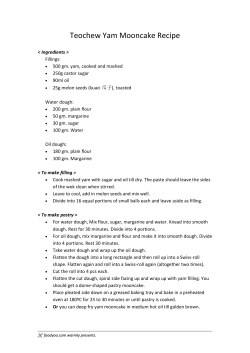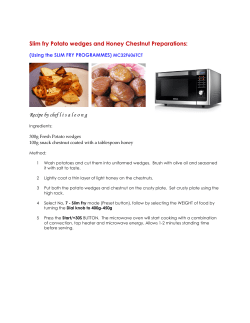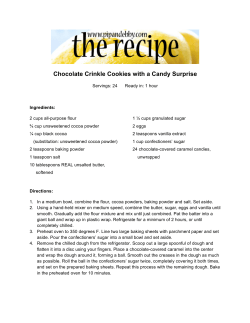
STACKABLE POTATO CHIPS TECHNOLOGY
Press Releases STACKABLE POTATO CHIPS TECHNOLOGY INTRODUCTION Buying a 2 USD can of stackable potato chips the snack consumer makes a clear choice for: consistency in shape and flavouring costly but protective and re-sealable packaging reformed potatoes versus natural potatoes. This means that the consumer is making a rational and not so impulsive choice. The increasing space for snacks - that are chosen as they show specific advantages - is the result of latest trends: the occasions for snacks are overlapping the ones for meals. Snacks manufacturers are pushing in this direction, increasing and diversifing their offer of pack size and styles, targeting the flavourings, but still using the potato as the first ingredient for salty snacks proposal. Pavan R&D team has been working on stackable potato chips technology since 1995, in order to satisfy the customers’ request. Important results have been reached and shared with customers. The availability of a small size industrial line for stackable potato chips into Pavan R&D center have significantly accelerated the development work since mid 2000. Every single step of the technology has been re-investigated; to improve texture and product surface appearance, most work has been focused on: formulations and raw materials quality dosing systems mixing and mixer design sheeting and rolls design scraps handling EXPERIMENTAL WORK Since all the items are strictly interdependent here are described only the most important steps that allowed clarifying the effect of each single variation on the items listed above. The main tool used in the development work has been the industrial line composed (at the beginning) by: dry raw material mixer / gravimetric doser for dry mix / additional volumetric doser for dry mix / double liquid dosage system with temperature controlled tanks / double stage dough mixing system / spreading conveyor / sheeting rolls / rotary cutter / scrap return system / a heat and control continuous fryer / seasoning conveyor / flipping device. Raw materials characteristics were assessed with standard American Association of Cereal Chemists methods and with Brabender visco-amylograph for the viscosity profiles. Main raw material characterization Potato flake is the main ingredient of the dry mix for stackable potato chips with typical amount ranging between 70 and 80 % of the dry mix. The other ingredients, with the exclusion of the oil for frying and the flavoring are: corn starch, potato starch, corn flour, sugars and dextrins. Important relationships have been determined between granulometry, viscosity profile and water absorption capability versus product machinability and product quality. Potato flakes in big particles (known as ‘whole flakes’) show a slow speed - compared to the same milled flakes - in absorbing water, resulting in parts with very high water content and others still completely dry. To improve water distribution, longer mixing times are requested but the outcome of this is a major work input to the dough which causes other problems described in the sheeting section. Press Releases This type of performance of the whole flakes, together with the poor consistency during dosage (due to stratification and the difficulty of transport) make clear that the ideal particle size of the flakes must be lower than 600 microns. The viscosity profile of the flakes, at the same particle size is also giving different product qualities in relation to the viscoelastic properties that the relevant dough are showing at the sheeting stage. 3 Viscosity Profiles The dry mix viscosity profile is strongly influenced by the flakes characteristics: to maintain it within the ideal range good results have been experienced in mixing some quantity of granules in substitution of flakes. Dosing step As described below a very fast continuous mixing process have been adopted. For this reason, the precise control of the dry and liquid inlet is a key point. Pavan adopted the gravimetric dosage of the dry materials and a sophisticated volumetric liquid multiple dosing system. The typical range of dry ingredients inlet is between 90 and 160 kg/h. Mixing step The continuous mixing of the dry ingredients with water has been preferred from the very beginning as the possible alternative to batch mixing. The main reason for this preference was the evidence of instability in the process when the mixed dough was held for different times before being sheeted. Pavan has a long and wide experience in continuous mixing systems and that’s why different potential combinations were tested. The most performing and flexible one is composed of two stages: the first one performs in an high speed pre-mixing device to guarantee a first homogeneous distribution of the liquid within the solid particles; the second one also performs at high rotational speed of the mixer to distribute the rework and, for some particular products, other solids through a second dosing system. The total mixing time can be adjusted following the water absorption characteristics of the dry mix, but in the most common situation, it does not exceed 20 seconds. The outcome of the development of the mixing process is that the dough can be sheeted immediately after reaching a uniform surface water distribution the dough. Any additional mixing time will generate dough with less surface water and so much more sensitive to the shear generated at the sheeting stage. Sheeting step The sheeting step have been revised at the initial stage of the development and, from the results of the pilot plant experiments, Pavan had the confirmation that a multiple reduction system was narrowing the possibilities of getting a controlled surface and texture of the product. The reason for this behavior is not yet conclusive but it appears that after being gauged once, the rheology of the dough changes completely from the initial one becoming much more sensitive to the shear stress and the water much more bound to the solid particles. As a result the potato chips tends to be more compact and the surface will not let the water exit easily. This situation generates big bubbles that can be eliminated only adding additives or additional re-wetting of the surface before frying. Cutting and rework handling The rotary cutters derived from the biscuit technology has become a standard in reformed potato chips production both wet fried or pellets type. In the case of stackable potato chips, the most important issue is the regularity of the cutting and the absence of movement of the cut chips. Each product must stay in its position on the transporting belt in order to be fed in the continuous fryer exactly aligned with the fryer moulds that will give the classical curved shape to the chip. The scrap resulting from the cutting ranges between 40 and 45% of the sheet surface and must be reintroduced in the dough to be sheeted and reused. Also for this important portion of the dough the amount of mechanical work input must be taken into consideration. Since it is necessary to introduce the rework in the mixer its particle size must be compatible with the dough, the reduction in pieces must be made in the most convenient and less stressing way. A double system of slitting rolls and sharp rotating blades cutter has demonstrated to be the best way of getting a good particle size reduction. The introduction of the rework into the dough is continuos so that, after starting up of the line, the time to reach the equilibrium in the sheet condition is very short as the total mixing, sheeting, scrap return takes less than one minute. Press Releases EXPERIMENTAL WORK CONCLUSIONS Although the process for making stackable reformed potato chips seems to be straightforward, as a matter of fact it is always necessary a precision control on the dosing of ingredients both solid and liquid, the control of the uniformity of sheet thickness, and the control of the alignment of individual chips during cutting, transfer and frying. The maintenance of constant frying conditions is another very important factor. For this reasons, the role of machines and equipments as well as raw material suppliers is fundamental in the maintenance of good quality product. Since the other phase of the process do not involve major issues from processing point of view, we describe them briefly in order to give to the readers a complete idea of the production line. OTHER PROCESS STEPS Frying and moulding: The frying time for stackable potato chips - as many other potato based wet fried products with similar 0.6 – 0.7 mm thickness - is ranging between 15 and 20 seconds with an oil temperature of 185 °C. The turn over of the oil in the type of fryer used for stackable potato chips is generally around 8 hours. Being the typical characteristics of this product its long shelf life, the oil quality and management must be at the highest possible standards. Cottonseed oil is the preferred choice for many customers but, since it is not easy and economically convenient in many Countries, refined palm oil remains the most popular choice. The exit of the fryer and the matching with the belt of the seasoning unit is one of the key points to have a good packaging performance. Considering the importance of the alignment after frying, different systems have been tested to ‘correct’ any misalignment of the chips out from the fryer: the result is an integrated system of belts and chains that maintain the chips in position during all the passages between one belt and the following one. Seasoning device: The variety of seasonings necessary to cover the market request led to the need of different seasoning units designed around the seasoning characteristics. A particular volumetric system gives each row the same volume of seasoning. Due to the different characteristics of the powders the design of the delivery system must be able to carry different solutions. Generally it is necessary to have at least one system for high bulk density and free flowing seasonings and another one for the ones with more packing tendency. After dosage of the seasoning the spreading onto the chips is done with a series of small vibrating sieves. Portioning and Packaging: The importance of this section is clear when comparing the shelf attraction of a can or a nice carton box with a tray in it against the common form/seal bags. The first phase necessary to obtain a good portioning is the flipping upside down of all chips in order to form a kind of continuous ‘rope’ that can be handled and moved at much lower speed than the single chips. After testing many mechanical devices to flip the chips that are coming at a rate from 5 chips per second up, the system based on a compressed air flow remains the most suitable for the purpose. The transfer of the ‘rope’ of chips from the flipping to the portioning unit can be made efficiently by means of vibrating channels. Portioning is a volumetric operation that relies on the uniformity of the weight of the chips between the rows. Typical portioning are 200 grams, 100 grams or 50 grams. In some cases - typically in the copacking - there may be the need of different packing types: cans, flow pack, trays plus flow pack. In all these situations the best option is still the semi-automatic set up. If the packaging is done automatically, each row is directed to a unit that put the portion of the chips in the can or in the tray. The package is then checked for weight, nitrogen flushed and sealed. As mentioned before, one critical element for distribution is the shelf life of the stackable potato chips. Package quality, very low oxygen residual content, oil quality, are the key elements to guarantee the shelf life. With can packaging and simple nitrogen flushing a 6 months shelf life is normally achieved. To reach 12 months, nitrogen flushing and can sealing must be able to maintain an residual oxygen level of less than 4%. Authors: Luciano Mondardini - Pavan R&D Director Luisito Virtucio - Pavan New Products Development Manager
© Copyright 2025




